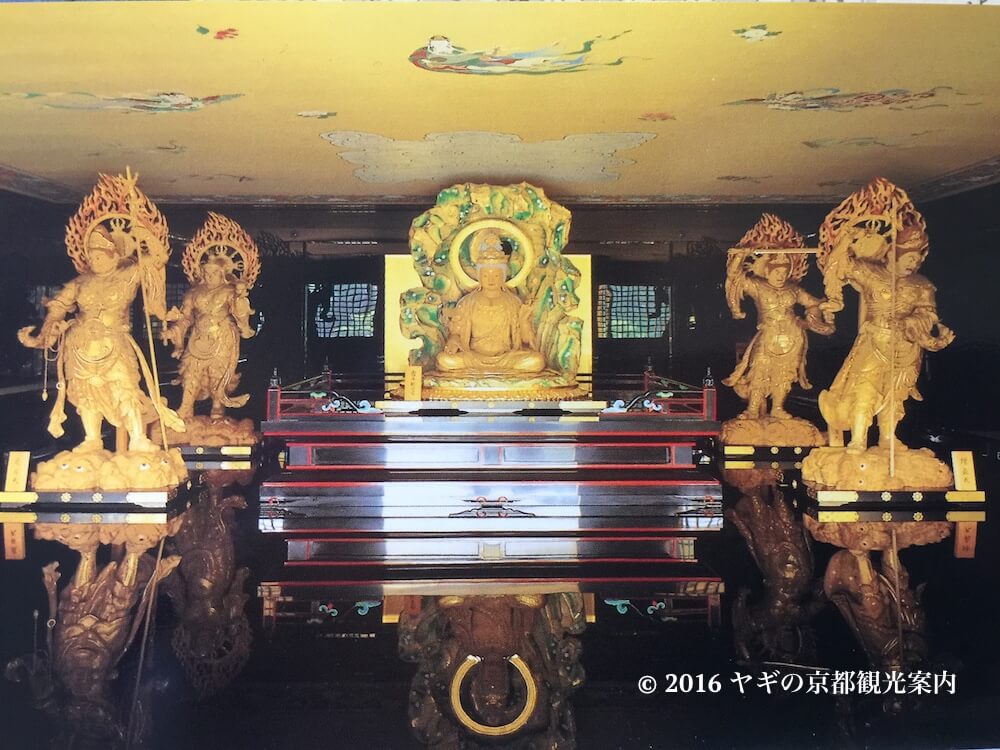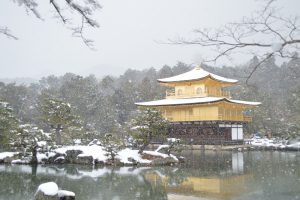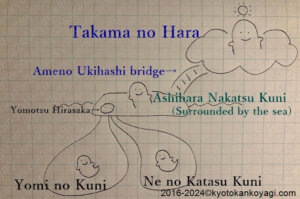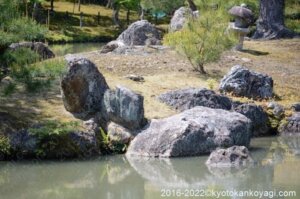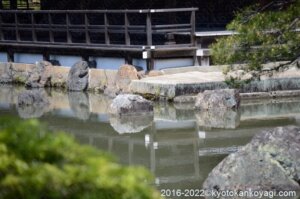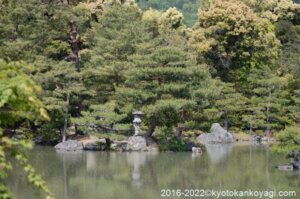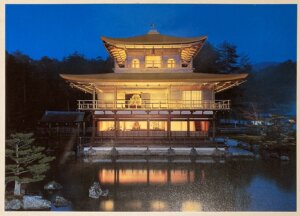THE GIST OF THIS ARTICLE
- Page 1 Introduction, About Kinkakuji, the golden pavilion (Shariden), the 1st floor.
- Page 2 The 2nd floor, the 3rd floor, the way to admire Sahriden
- Page 3 The prolific garden, night illumination on post card
- Page 4 Other Must-sees
- Page 5 Autume leaves and snow, access, etc.
The following is the contents of this article.
The garden and Kyokochi pond 庭園(鏡湖池)
Overview
The pond in front of Shareide is called Khyokochi pond. The garden of Kinkakuji was intended to admire views form a boat on it. Today, we stroll around it and we couldn’t see what the garden is exactly.
As described in a post of Zen garden, traditional gardens stand for at least island(s) and sea or lake and they usually hide something behind them.
In the garden of Kinkakuji, we can find the world in Japanese mythology, Horai, the art of eternal life, and the world in Buddhism.
Ashihara Jima island and Mt. Horai San 葦原島(蓬莱山)
The is land located in front of Shariden is called Ashigara Jima. Ashihara is an abbreviated “Toyo Ashihara Nakatsukuni” and Jima means “island.” It is a prolific in meaning.

Take a look at the picture. That’s the world in Japanese mythology. Takama no Hara is located up above the world and is a place the ancestor of our emperors come from.
Ashihara Nakatsu Kuni is where we live, i,e., the Japanese archipelago. The island stands for this.
And there is a bridge between two places. With a Hoko (something like a sword with long rod), Izanagi and Izanami (deities) gave birth to Ashihara Nakatsukui on it.
In addition to it, the island also hides Horaisan behind it. Horaisan is a mountain where eternal life is accomplished in Shinsen Horai in Taoism imported from ancient China in around the 7th century.
Furthermore, from a view on the side of Shariden, the garden looks like a typical ink wash painting in Song dynasty of ancient China. The art of duplicating a scene of ink washi paintings in a garden made traditional Japanese gardens developed into Karesansui gardens and the Rock Garden in Ryoanji is one of the earliest. This type of Karesanusi garden was found in the 16th century. The garden of Kinkakuij adopted the art earlier than Ryoanji.
Sanzon Seki Rocks 三尊石
Sanzon Seki is a group of three rocks. Each one stands for Buddhist deity. A rock in front of them is called Daiza Ishi. Daiza is a place to put something on. I suppose something like offerings in this case.

Fugen Bostsu, Shaka Nyorai (Siddhartha Gautama), and Monju Bosatsu from left to right.

They are duplications of the ones in the garden of Saihoji. The ones of Kinakuji is larger. The Sanzon Seki of Ginkakuji is also an abstract duplication of the ones in Saihoji.
Hosokawa Ishi Rock 細川石
The rock on Ashihara Jima was donated by Hosokawa Yoriyuki, the Kanrei (a kind of minister) of the Ashikaga Shogunate.

In a nutshell, Kanrei is a post next to Shogun.
Yodomari Ishis 夜泊石(よどまりいし)
Yodomari Ishis stand for ships head for Horai San.
Kame Shima and Tsuru Shima islands 亀島と鶴島
In front of Shariden, there are five Kame shimas and three Tsurushimas. Kame (turtle) and Tsuru (crane) is believed to bring us prosperity.
Kusen Hakkai 九山八海
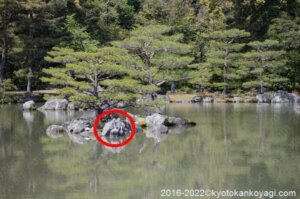
Kusen Hakkai means eight mountains and nine seas around Syumisen. The world in Buddhism consists of them.
Hatakeyama Ishi rocks 畠山石
It was donated by Hatakeyama, the Kanrei and stands for Mt. Fuji.
Awaji Shima island 淡路島
The island behind Hatakeyama Ishi. The fist island two deities gave birth to on the Ameno Ukihashi bridge.
Night illumination ライトアップ
We can only see Shariden illuminated in a post card.
ヤギの京都観光案内/KYOTO GOAT BLOGをもっと見る
購読すると最新の投稿がメールで送信されます。

